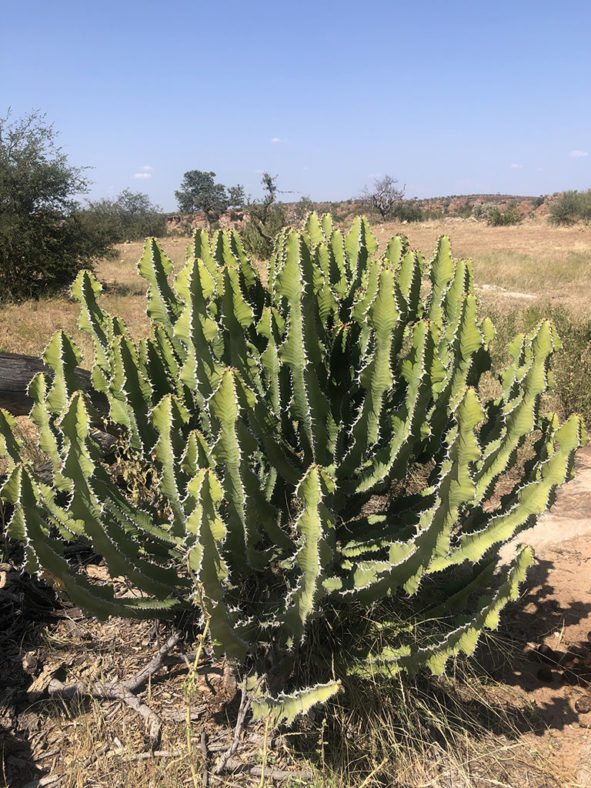Scientific Name
Euphorbia cooperi N.E.Br. ex A.Berger
Common Name(s)
Bushveld Candelabra Euphorbia, Bushveld Candelabra Tree, Candelabra Euphorbia, Candelabra Tree, Transvaal Candelabra Tree
Synonym(s)
Euphorbia cooperi var. cooperi
Scientific Classification
Family: Euphorbiaceae
Subfamily: Euphorbioideae
Tribe: Euphorbieae
Subtribe: Euphorbiinae
Genus: Euphorbia
Etymology
The specific epithet "cooperi" honors Thomas Cooper (1815-1913), an English botanist and plant explorer who collected plants in South Africa from 1859 to 1862.
Origin
The native range of Euphorbia cooperi is wooded grassland and rocky places from the KwaZulu-Natal province of South Africa, through Swaziland (now Eswatini), up to Mpumalanga and Limpopo provinces of South Africa, southern Mozambique, and eastern Botswana.
Description
Euphorbia cooperi is a succulent tree with a stout, cylindrical trunk and branches that curve upwards and occasionally re-branch, forming a rounded, flat-topped crown. It can grow up to 29.5 feet (9 m) tall. The younger plants are shrub-like and can reach up to 6.6 feet (2 m) in height. The trunk can grow up to 14 inches (35 cm) in diameter, has rough, fissured, greyish-brown bark, and is scarred from fallen branches. The branches are fleshy, distinctly winged, deeply and variably constricted into pear-shaped to subcircular segments that can grow up to 20 inches (50 cm) long. They can reach up to 8 inches (20 cm) across. The spine shields are joined, forming a continuous horny margin to the wings. They become corky on older branches and bear paired, grey spines with blackish tips. The spines can grow up to 0.4 inches (1 cm) long. The leaves are rudimentary, scale-like, and soon drop off.
The cyathia are yellowish-green to golden yellow and vertically arranged in 1 to 3 horizontally arranged cymes. They can reach up to 0.3 inches (0.8 cm) in diameter. The fruits are distinctly 3-lobed capsules exserted on a stout pedicel that can grow up to 0.4 inches (1 cm) long. They are green and dark purple on the apex and along the angles, glabrous, and can grow up to 0.4 inches (1 cm) long and 0.5 inches (1.3 cm across.

How to Grow and Care for Euphorbia cooperi
Light: This succulent is a sun lover. Place your indoor E. cooperi in a sunny window. You may place the pot on the balcony or in the garden from spring to fall. Increase sun exposure gradually to prevent sunburn.
Soil: E. cooperi requires well-drained soil. Use a commercial potting mix formulated for succulents, or make your own.
Temperature: High summer temperatures are not a problem, but low winter temperatures can damage or kill your plant. E. cooperi can withstand temperatures as low as 25 °F (-3.9 °C). USDA Plant Hardiness Zones 9b to 11b, 25 to 50 °F (-3.9 to 10 °C).
Watering: From spring to fall, water when the top inch (2.5 cm) of soil feels dry. Reduce watering in winter. Give it just enough water to prevent wilting. The best time of the day to water your E. cooperi in the warm season is the evening.
Fertilizing: Plants in a pot need regular feeding. Apply a balanced fertilizer in a 10-10-10 NPK formulation, diluted to 1/4 strength weekly during the growing season.
Repotting: E. cooperi will benefit from repotting, but it does not need to be repotted yearly. When your plant is outgrowing its pot, it is time to repot it in a larger pot and give it a fresh potting mix. The repotting is best done in early spring, at the beginning of the growing season. Wear gloves, protective clothing, and appropriate eye protection when repotting this succulent.
Propagation: The easiest and fastest propagation method for this plant is by stem cuttings. It can also be grown from seeds, but it can be difficult for seeds to germinate. The best time to take cuttings is in spring or summer. Sow the seeds in spring.
Learn more at How to Grow and Care for Euphorbia.
Toxicity of Euphorbia cooperi
E. cooperi produces a toxic white milky sap that can irritate the skin and eyes. Therefore, keeping your plant away from children and pets is best.
Links
- Back to genus Euphorbia
- Succupedia: Browse succulents by Scientific Name, Common Name, Genus, Family, USDA Hardiness Zone, Origin, or cacti by Genus
Photo Gallery
Click on a photo to see a larger version.


